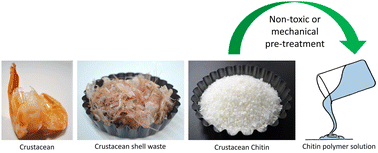Comprehensive review on pre-treatment of native, crystalline chitin using non-toxic and mechanical processes in preparation for biomaterial applications
Abstract
Chitin is a polymer of N-acetylglucosamine and provides structure and stability to the exoskeleton of crustaceans, insects and fungal cell walls. Intermolecular hydrogen bonds between polymer chains create a very tight crystalline fibre network with excellent mechanical properties. Chitins’ antimicrobial properties and high biocompatibility make it an attractive polymer source for the production of nanomaterials such as hydrogels, films, or highly porous nano foams. To date, commercial utilization of native chitin has been limited due to its insolubility in aqueous solutions and most common solvents. Instead, chemical modifications such as deacetylation or depolymerization are used to make chitin soluble and easier to work with but as a consequence, chitin loses some of its mechanical stability. Other approaches for chitin dissolution employ toxic chemicals, potentially negating biomedical and food applications. This review summarizes pre-treatment methods for dissolution or fibrillation of native chitin fibre using non-toxic and mechanical approaches and how it relates to the macrostructure of the species of origin.

- This article is part of the themed collection: Green Chemistry Reviews


 Please wait while we load your content...
Please wait while we load your content...